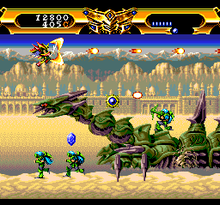
The Sega CD, known as Mega-CD in most regions outside North America and Brazil, is a CD-ROM accessory for the Sega Genesis produced by Sega as part of the fourth generation of video game consoles. It was released on December 12, 1991, in Japan, October 15, 1992, in North America, and April 2, 1993, in Europe. The Sega CD plays CD games and adds hardware functionality such as a faster CPU and graphic enhancements such as sprite scaling and rotation. It can also play audio CDs and CD+G discs.

The TurboGrafx-16, known as the PC Engine outside North America, is a home video game console designed by Hudson Soft and sold by NEC Home Electronics. It was the first console marketed in the fourth generation, commonly known as the 16-bit era, though the console has an 8-bit central processing unit (CPU) coupled with a 16-bit graphics processor. It was released in Japan in 1987 and in North America in 1989. In Europe the Japanese model was unofficially imported and distributed in the United Kingdom and France from 1988. In Japan, the system was launched as a competitor to the Famicom, but the delayed United States release meant that it ended up competing with the Sega Genesis and later the Super NES.
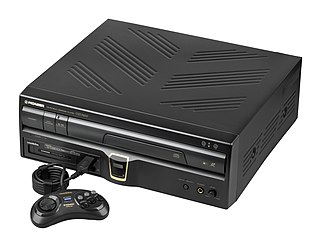
The LaserActive is a converged device and fourth-generation home video game console capable of playing LaserDiscs, Compact Discs, console games, and LD-G karaoke discs. It was released by Pioneer Corporation in 1993. In addition to LaserActive games, separately sold add-on modules accept Mega Drive/Genesis and PC Engine/TurboGrafx-16 ROM cartridges and CD-ROMs.

Raiden is a 1990 vertically scrolling shooter arcade video game developed by Seibu Kaihatsu and published by Tecmo in Japan. The game's story takes place in the year 2090, when an alien species known as the Crystals invaded Earth. Players assume the roles of the Vanquish Crystal Defense pilot duo, taking control of two state of the art Fighting Thunders aircraft to defeat the Crystals and save the Earth.
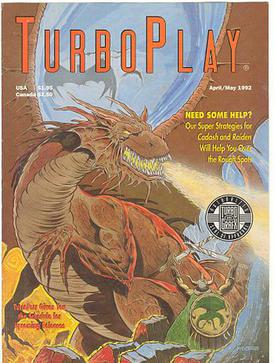
TurboPlay Magazine is a bi-monthly, U.S.-based video game magazine which was published by L.F.P. from June/July 1990 through August/September 1992. It was available via subscription only. A total of 14 issues were released, on schedule. TurboPlay exclusively covered NEC's line of video game consoles, especially the North American models: TurboGrafx-16, TurboGrafx-CD (TG-CD), Turbo Duo (DUO) and the handheld TurboExpress. NEC's SuperGrafx also received some minor coverage.

The TurboDuo is a fourth-generation video game console developed by NEC Home Electronics and Hudson Soft for the North American market. The TurboDuo was test-marketed in Los Angeles in October 1992, before a nationwide rollout in May 1993. It is the North American version of the Japanese PC Engine Duo game console which was released in September 1991.

Streets of Rage 2, known as Bare Knuckle II in Japan, is a 1992 side-scrolling beat 'em up video game published by Sega for the Genesis/Mega Drive. A sequel to Streets of Rage (1991), the characters Axel Stone and Blaze Fielding return while the game also introduces two new characters: Max Thunder, and Eddie "Skate" Hunter, the younger brother of Adam Hunter from the first game.
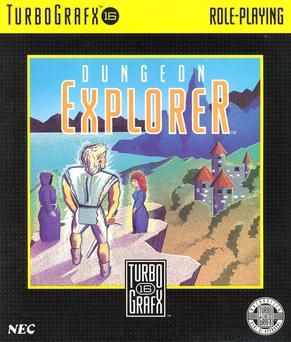
Dungeon Explorer is an action role-playing video game developed by Atlus for the TurboGrafx-16 and originally published by Hudson Soft in Japan on March 4, 1989, and later in North America by NEC on November 15 of the same year. The first installment in the eponymous franchise, the game is set in the land of Oddesia, which has been overrun by an alien race and where players assume the role of one of eight main characters tasked with recovering the Ora stone to kill the alien king Natas. Co-directed by Kazutoshi Ueda and Yōsuke Niino, the title was created by most of the same team that would work on later several projects such as entries in the Megami Tensei series. Though it was initially launched for the TurboGrafx-16, it was later re-released through download services for various consoles.
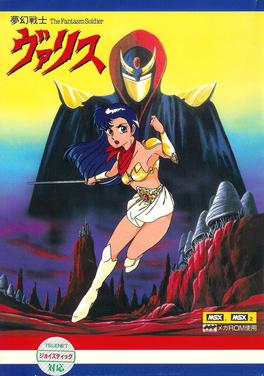
Valis: The Fantasm Soldier is a 1986 action-platform video game originally developed by Wolf Team and published by Telenet Japan for the MSX, PC-8801, X1, FM-7, and PC-9801 home computers. It is the first entry in the Valis series. It stars Yuko Asou, a Japanese teenage schoolgirl chosen as the Valis warrior and wielder of the mystical Valis sword to protect the Earth, the land of spirits, and the dream world Vecanti from demon lord Rogles. Throughout the journey, the player explores and search for items and power-ups, while fighting enemies and defeating bosses to increase Yuko's attributes.
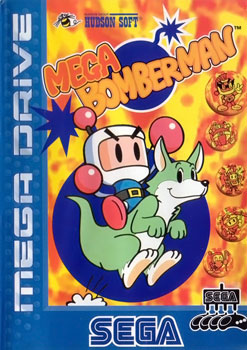
Bomberman '94 is a video game from the Bomberman series which was developed and published by Hudson Soft for the PC Engine and released on December 10, 1993, in Japan. It was later re-developed by Westone and re-published by Sega as Mega Bomberman on the Sega Mega Drive/Genesis in 1994 in other areas. The PC Engine Bomberman '94 was later released outside Japan through the Virtual Console and the PlayStation Network.

Valis III is a 1990 action-platform video game originally developed by Laser Soft, published by Telenet Japan and NEC for the TurboGrafx-CD. A Sega Genesis version was released in 1991. It is the third entry in the Valis series. It stars Yuko Asou, a Japanese teenage schoolgirl chosen as the Valis warrior and wielder of the mystical Valis sword after the events of Valis II. King Glames, wielder of the sword Leethus, leads denizens of the dark world to conquer both Vecanti and Earth, seeking refuge for his people amid the destruction of their planet. Together with the demon warrior-maiden Cham and her sister Valna, Yuko must prevent Glames from destroying both worlds. Through the journey, the player explores and searches for items and power-ups while fighting enemies and defeating bosses.

Valis II is a 1989 action-platform video game originally developed by Laser Soft, published by Telenet Japan and NEC for the PC Engine CD-ROM²/TurboGrafx-CD. A home computer version was released for PC-8801, MSX2, PC-9801 and X68000. A super deformed-style remake was also released in 1992 for the Sega Mega Drive/Genesis. It is the second entry in the eponymous series. It stars Yuko Asou, a Japanese schoolgirl teenager chosen to become the Valis warrior by wielding the titular mystical sword, after defeating the demon lord Rogles. The dream world Vecanti fell under the rule of emperor Megas, whose hatred towards his brother Rogles and bloodthirsty tendencies seeks to wipe out traces of the former tyrant, including his supporters. Gameplay varies between each version but all share similar elements, as the player explores and search for items and power-ups, while fighting enemies and defeat bosses.

Gate of Thunder is a 1992 scrolling shooter video game developed by Red Company and published by Hudson Soft for the TurboGrafx-CD. It was the first game released in North America to support the Super CD-ROM² format and served as one of the pack-in games for the TurboDuo, a two-in-one system which runs both TurboGrafx-CD and TurboGrafx-16 titles, where it was bundled with Bonk's Adventure, Bonk's Revenge and Bomberman on the same disc. In the game, the player controls the Hunting Dog space fighter craft, piloted by space cop Hawk. Alongside his ally Esty, piloting the Wild Cat support ship, Hawk must stop General Don Jingi and his Obellon armada from obtaining the powerful "Starlight" energy source from planet Aries.
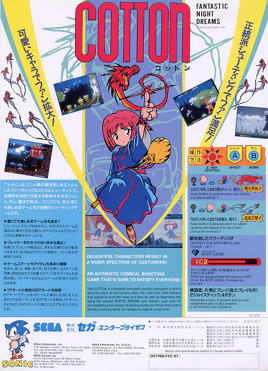
Cotton: Fantastic Night Dreams is a scrolling shooter video game developed by Success and originally released in Japanese arcades in 1991. The first installment in the Cotton series, players assume the role of the young witch Cotton who, alongside her fairy companion Silk, sets out on her broomstick on a quest to defeat several monsters and get her Willow candy. Its gameplay mainly consists of shooting mixed with role-playing game elements using a main two-button configuration. It ran on the Sega System 16 hardware.
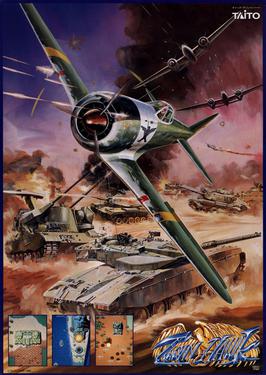
Twin Hawk is a 1989 vertically scrolling shooter arcade video game originally developed by Toaplan and published by Taito. Taking place at the end of an alternative World War II setting, where general Giovanni and his army plots to take over the fictional country Gorongo, players assume the role of a wing commander from the Daisenpū squadron taking control of a Flying Fortress fighter aircraft in an effort to overthrow the enemy.
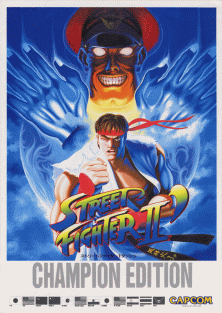
Street Fighter II: Champion Edition, released as Street Fighter II Dash in Japan, is a fighting game released by Capcom in 1992. It was launched for arcades and converted to several video game consoles. It is the first of several updated versions of Street Fighter II, and part of the Street Fighter series. The main changes are the addition of the four grand masters as playable characters and mirror matches. The fighting techniques of the eight main characters from the original game were further balanced for competitive play.
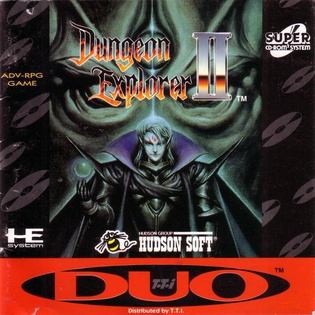
Dungeon Explorer II is an action role-playing video game developed and originally published by Hudson Soft for the TurboDuo in Japan on March 26, 1993, and in North America by Turbo Technologies in October of the same year. A sequel to 1989's Dungeon Explorer, it is the second installment in the eponymous franchise.

Seirei Senshi Spriggan is a 1991 vertically scrolling shooter video game developed by Compile and published by Naxat Soft in Japan for the PC Engine CD-ROM². In the game, the player assume control of Jega and Rikart piloting the Spriggan in order to protect their country from the Buraizubara empire.
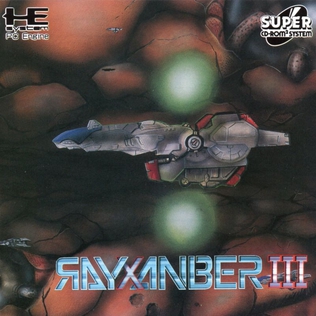
Rayxanber III is a 1992 scrolling shooter video game developed and published by Data West for the PC Engine Super CD-ROM². It is a follow-up to Rayxanber II, which was released earlier in 1991 for the PC Engine CD-ROM², and the last entry in the Rayxanber trilogy. In the game, the player assumes the role of a fighter pilot controlling the ES3 Donner Kyle space craft deployed into the homeworld of the Zoul Empire, in retaliation for the destruction of a mother ship from Earth. It retains the same gameplay as its predecessors, with the players fighting against an assortment of enemy forces while avoiding collision with their projectiles and other obstacles.

Spriggan Mark 2: Re-Terraform Project is a 1992 horizontally scrolling shooter video game developed by Compile and published in Japan by Naxat Soft for the PC Engine Super CD-ROM². It is a follow-up to Seirei Senshi Spriggan (1991). The game follows lieutenant Greg Erwin piloting the armed Bartholomeu armor and later the Spriggan Mark 2 in a war between two opposing forces to decide the fate of a space colony at Mars. The player must fight against waves of enemies to avoid collision with their projectiles and other obstacles, while intermissions between characters during gameplay advances the storyline.

